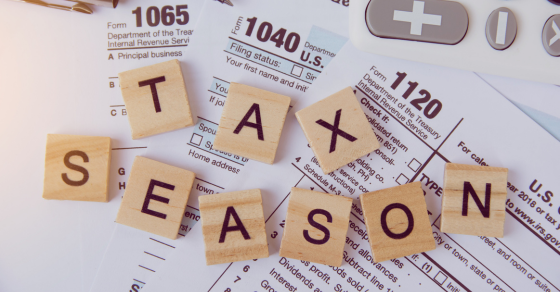|
As we venture into a new tax year, optimizing your financial strategy can significantly impact the amount you pay in income taxes. Here are the top 5 strategies to help you reduce taxable income and keep more money in your pocket come tax season:
1. Maximize Retirement Contributions: Contribute the maximum allowable amount to your retirement accounts, such as 401(k)s and IRAs. These contributions not only secure your financial future but also reduce your taxable income. Do note, there are income and eligibility limits and phaseouts to consider before making these contributions. 2. Leverage Health Savings Accounts (HSAs): If you have a high-deductible health plan, consider contributing to an HSA. Your contributions are tax-deductible, and withdrawals for qualified medical expenses are tax-free, providing a double tax benefit. 3. Explore Itemizing Deductions: Itemizing deductions can be a powerful tool. Deductible expenses may include medical expenses & mileage in excess of 7.5% of your Adjusted Gross Income, mortgage interest, state and local taxes, charitable contributions, and mileage. Analyze whether itemizing is more advantageous than taking the standard deduction. 4. Make Charitable Donations: Boost your philanthropic efforts while reducing your tax liability by making charitable donations. Contributions to qualified charities are tax-deductible and can make a meaningful impact on both your community and your tax return. There are many strategies available within this space. Reach out to Cornbelt Financial to find out the best strategies to fit your specific needs. 5. Take Advantage of Tax Credits: Investigate tax credits available for specific actions. For instance, consider solar and alternative fuel vehicle tax credits. Installing solar panels at home or purchasing an electric vehicle can not only benefit the environment but also provide valuable tax credits. Bonus Tip: Education Credits and Tuition Deductions: If you're pursuing higher education or have eligible dependents in college, explore education credits like the American Opportunity Credit or the Lifetime Learning Credit. Additionally, you may qualify for deductions related to tuition, student loan interest, or contributions to state-sponsored education plans such as a 529 plan. Implementing these strategies can help position you for a more tax-efficient year. However, tax laws are complex and subject to change often, so it's advisable to consult with a tax professional like Cornbelt Financial to tailor these general strategies to your unique financial situation. By taking proactive steps and staying informed about available deductions and credits, you can navigate the tax landscape strategically, reduce your taxable income, and ultimately pay less in taxes for the year 2024. As a savvy business owner, navigating the complexities of financial planning and strategic decision-making is key to ensuring the longevity and success of your enterprise. One invaluable tool that often gets overlooked is a comprehensive business valuation.
At Cornbelt Financial, we understand the importance of empowering business owners with the insights a business valuation can provide. We leverage cutting-edge technology to make business valuations more accessible, cost-effective, and efficient. With over 200 million businesses worldwide and 40 million business owners expected to sell within the next decade, now is the time to take charge of your financial future. Here are the top 8 reasons why every business owner should consider getting a business valuation: 1. Retirement and Succession Planning A business valuation serves as a crucial component of retirement and succession planning. Knowing the true value of your business allows you to make informed decisions about your financial future and ensures a smooth transition when passing the torch. 2. Mergers & Acquisitions Whether you're considering acquiring another business or positioning yours for a potential merger, a business valuation provides critical insights into the fair market value, facilitating informed negotiations and strategic decision-making. 3. Sale of Your Business When the time comes to sell your business, having a recent business valuation streamlines the process, instills confidence in potential buyers, and helps ensure you receive fair market value for your hard work and dedication. 4. Seeking Investments Investors look for businesses with a clear understanding of their worth. A business valuation not only attracts potential investors but also provides a solid foundation for negotiating investment terms. 5. Buy-Sell Agreements For businesses with multiple owners, a buy-sell agreement is vital. A business valuation establishes a fair market value, providing a basis for determining buyout prices in the event of an owner's departure or retirement. 6. Key Person Insurance Identifying and insuring key individuals within your business is essential. A business valuation helps determine the financial impact of losing a key person, allowing you to tailor insurance coverage accordingly. 7. Financing and Partner Buyouts Lenders often require a business valuation when considering financing applications. Additionally, in the case of a partner buyout, a valuation establishes the basis for fair compensation, fostering a transparent and amicable process. 8. Divorce Proceedings In the unfortunate event of divorce, a business valuation ensures fair and equitable distribution of assets, safeguarding both parties' interests. The importance of a business valuation cannot be overstated, especially in a landscape where 78% of business owners expect to fund their retirement through the sale of their business. Unfortunately, many are under-insured or lack life insurance due to the perceived complexities and expenses involved in the valuation process. Don't let your business value remain a mystery, reach out to Cornbelt Financial today. Learn more about our streamlined business valuation services and take the first step toward unlocking the full potential of your business. Request a business valuation today and embark on a journey of financial empowerment. Your business deserves to be valued — and so do you. As the upcoming tax season approaches, small business owners are gearing up to make the most of available deductions and credits. Understanding and leveraging these tax benefits can significantly impact your bottom line. Here are the top six small business tax deductions to consider for your upcoming return:
1. Section 179 & Bonus Depreciation The Section 179 deduction and Bonus Depreciation are powerful tools that allow businesses to deduct the full cost of qualifying equipment and software purchased during the tax year. This can provide immediate tax relief and incentivize investments in business assets. 2. Home Office Deduction For entrepreneurs who operate out of a home office, the Home Office Deduction can lead to substantial tax savings. The simplified method, based on square footage, streamlines the process. However, for a more accurate deduction, consider calculating the percentage of your home used for business, along with eligible expenses like mortgage interest, utilities, property taxes, and maintenance. 3. Vehicle Expense Tracking both total mileage and business mileage is crucial for claiming vehicle expenses. If the vehicle is used exclusively for business, it simplifies matters. For those wanting to claim depreciation, meticulous tracking of actual expenses, such as interest, lease payments, insurance, and maintenance, is necessary. Tools like MileIQ can help streamline mileage tracking. 4. Small Business Health Insurance Small business owners paying for their health insurance or offering health insurance to employees may qualify for the Small Business Health Insurance Deduction and in some instances a Small Business Health Care Tax Credit. This deduction and/or the credit can help alleviate the financial burden of paying for health coverage, making it a valuable incentive for businesses to prioritize employee well-being. 5. Qualified Business Income Deduction The Qualified Business Income (QBI) Deduction is designed to benefit business owners, providing a deduction of up to 20% of qualified business income. However, it's essential to note that the deduction can be phased out based on income levels and varies depending on factors like business industry, type, wages paid, and filing status. This deduction has a few methods of calculation which can create some complexities for estimating the total deduction. 6. Employee Retirement Contributions Contributions to employee retirement plans not only help secure the financial future of your team but can also result in tax benefits for your business. Additionally, for those implementing a new retirement plan, a tax credit is available to offset start-up costs. For Colorado employers, the Colorado SecureSavings program increases an employer's need for considering retirement plan options. By strategically leveraging these small business tax deductions, you can optimize your financial position and navigate tax season with confidence. If you need additional support or have questions on your small business deductions, please reach out to your Cornbelt Financial team member today! As we approach the upcoming tax season, getting organized is key to a stress-free experience. To ensure a smooth process, we encourage our clients to start early and compile the necessary documents well in advance. Here's a handy guide to help you prepare for the tax season:
Organization Tips:
1. Sources of Income:
1. Financial Statements:
Revolutionizing Client Engagement: Cornbelt Financial Adopts Canopy for Streamlined Operations11/27/2023
At Cornbelt Financial, we are committed to staying at the forefront of technology to enhance our services and provide an unparalleled experience for our clients. We are excited to announce our adoption of Canopy, a cutting-edge platform that will revolutionize how we manage operations and interact with our clients.
Streamlining Operations for Efficiency One of the key reasons we chose Canopy is its ability to streamline our internal operations. The platform offers a centralized hub for document management, task tracking, and communication. This means faster response times, improved organization, and a more efficient workflow for our team. Enhancing Client Experience through the Client Portal The heart of this transformation lies in the client portal. This secure, user-friendly interface allows our clients to access their financial documents and stay informed all in one place. This centralized approach ensures that our clients have instant access to the information they need, fostering a more transparent and collaborative relationship. Benefits of the Canopy Client Portal
The Power of Mobility with Canopy's Mobile App Recognizing the importance of mobility in today's fast-paced world, Canopy offers a robust mobile app. Our clients can now manage their financial matters from the palm of their hand. The app provides the similar functionality as the desktop version, ensuring a consistent and convenient user experience. Conclusion: A New Era of Financial Management The implementation of Canopy marks a significant step forward for Cornbelt Financial and our commitment to provide a top-tier service. This innovative platform allows us to offer a more personalized and efficient experience for our clients, helping them achieve their financial goals with greater ease. As we embark on this journey with Canopy, we are excited about the positive impact it will have on our operations and the enhanced experience it will deliver to our clients. At Cornbelt Financial, we believe that having a comprehensive financial plan is essential for building a strong foundation and achieving your financial goals. Whether you're just starting out on your journey to adulthood or preparing for retirement, a financial plan provides guidance and peace of mind.
Let's explore the four phases of life where a financial plan can make all the difference:
At Cornbelt Financial, our financial planning services encompass a range of essential elements to ensure a comprehensive approach:
By partnering with Cornbelt Financial, you gain access to our expertise and personalized guidance throughout your financial journey. We understand that each phase of life presents unique challenges and opportunities, and we are here to help you navigate them all. Don't underestimate the power of a comprehensive financial plan. Contact us today to learn more about how Cornbelt Financial can create a tailored financial roadmap that aligns with your goals, priorities, and dreams. Identifying tax phishing threats is crucial to protect yourself from falling victim to scams and potential financial loss. Here are several key indicators to help you recognize and steer clear of tax phishing attempts.
Are you a small business owner operating as an S-Corporation? If so, reasonable compensation is a crucial concept in the realm of business and taxation. But what exactly does reasonable compensation mean, and why is it so important?
Reasonable compensation refers to the amount of salary or wages that an S-Corporation pays to its owner-employee(s) who are actively involved in the day-to-day operations of the business for the services they provide to the company. S-Corps, as pass-through entities, allow the income generated by the business to pass through to the shareholders, who then report and pay taxes on their respective shares of the profits. However, the Internal Revenue Service (IRS) requires S-Corp owners to receive reasonable compensation for their work to prevent the evasion of payroll taxes. But why is reasonable compensation important? There are a few key reasons:
How do you report Reasonable Compensation? At Cornbelt Financial, we leverage Gusto, a comprehensive payroll platform, to help process payroll for S-Corporations. Gusto streamlines the payroll process, making it easy to accurately calculate and document reasonable compensation, ensuring that your payroll is in compliance with IRS guidelines. However, determining reasonable compensation can be complex and involves consideration for multiple factors such as the nature of the business, qualifications and responsibilities of the owner, your role and time spent in the business, industry standards, geographic location, job market, and the financial performance of your company. In summary, reasonable compensation should be the fair and justifiable amount that an individual would be paid for similar services in a similar industry and geographic location. It's important for S-Corp owners to strike the right balance when setting their salary. On one hand, paying a reasonable salary ensures compliance with IRS regulations and helps avoid penalties. On the other hand, setting an unreasonably low salary and taking the majority of income as distributions could raise red flags during an IRS audit. Therefore, seeking our guidance can be beneficial in determining an appropriate salary. Our team of experts at Cornbelt Financial specializes in providing guidance and support for S-Corporations. We can help you navigate the complexities of reasonable compensation, ensuring that you strike the right balance between a fair salary and optimizing tax advantages. Contact us today to discuss your S-Corporation's compensation strategy and learn how Cornbelt Financial and Gusto can simplify the payroll process while ensuring compliance with reasonable compensation guidelines. Classifying workers as independent contractors — rather than employees — can save businesses money and provide other benefits. But the IRS is on the lookout for businesses that do this improperly to avoid taxes and employee benefit obligations.
To find out how the IRS will classify a particular worker, businesses can file optional IRS Form SS-8, “Determination of Worker Status for Purposes of Federal Employment Taxes and Income Tax Withholding.” However, the IRS has a history of reflexively classifying workers as employees, and filing this form may alert the IRS that your business has classification issues — and even inadvertently trigger an employment tax audit. Contractor vs. employee status A business enjoys several advantages when it classifies a worker as an independent contractor rather than as an employee. For example, it isn’t required to pay payroll taxes, withhold taxes, pay benefits or comply with most wage and hour laws. On the downside, if the IRS determines that you’ve improperly classified employees as independent contractors, you can be subject to significant back taxes, interest and penalties. That’s why filing IRS Form SS-8 for an up-front determination may sound appealing. But because of the risks involved, instead of filing the form, it can be better to simply properly treat independent contractors so they meet the tax code rules. Among other things, this generally includes not controlling how the worker performs his or her duties, ensuring you’re not the worker’s only client, providing Form 1099 and, overall, not treating the worker like an employee. Be prepared for workers filing the form Workers seeking determination of their status can also file Form SS-8. Disgruntled independent contractors may do so because they feel entitled to health, retirement and other employee benefits and want to eliminate self-employment tax liabilities. After a worker files Form SS-8, the IRS sends a letter to the business. It identifies the worker and includes a blank Form SS-8. The business is asked to complete and return it to the IRS, which will render a classification decision. But the Form SS-8 determination process doesn’t constitute an official IRS audit. Passing IRS muster If your business properly classifies workers as independent contractors, don’t panic if a worker files a Form SS-8. Contact us before replying to the IRS. With a proper response, you may be able to continue to classify the worker as a contractor. We also can assist you in setting up independent contractor relationships that can pass muster with the IRS. © 2018 Whether you’re claiming charitable deductions on your 2017 return or planning your donations for 2018, be sure you know how much you’re allowed to deduct. Your deduction depends on more than just the actual amount you donate.
Type of gift One of the biggest factors affecting your deduction is what you give: Cash. You may deduct 100% gifts made by check, credit card or payroll deduction. Ordinary-income property. For stocks and bonds held one year or less, inventory, and property subject to depreciation recapture, you generally may deduct only the lesser of fair market value or your tax basis. Long-term capital gains property. You may deduct the current fair market value of appreciated stocks and bonds held for more than one year. Tangible personal property. Your deduction depends on the situation:
Vehicle. Unless the vehicle is being used by the charity, you generally may deduct only the amount the charity receives when it sells the vehicle. Use of property. Examples include use of a vacation home and a loan of artwork. Generally, you receive no deduction because it isn’t considered a completed gift. Services. You may deduct only your out-of-pocket expenses, not the fair market value of your services. You can deduct 14 cents per charitable mile driven. Other factors First, you’ll benefit from the charitable deduction only if you itemize deductions rather than claim the standard deduction. Also, your annual charitable donation deductions may be reduced if they exceed certain income-based limits. In addition, your deduction generally must be reduced by the value of any benefit received from the charity. Finally, various substantiation requirements apply, and the charity must be eligible to receive tax-deductible contributions. 2018 planning While December’s Tax Cuts and Jobs Act (TCJA) preserves the charitable deduction, it temporarily makes itemizing less attractive for many taxpayers, reducing the tax benefits of charitable giving for them. Itemizing saves tax only if itemized deductions exceed the standard deduction. For 2018 through 2025, the TCJA nearly doubles the standard deduction — plus, it limits or eliminates some common itemized deductions. As a result, you may no longer have enough itemized deductions to exceed the standard deduction, in which case your charitable donations won’t save you tax. You might be able to preserve your charitable deduction by “bunching” donations into alternating years, so that you’ll exceed the standard deduction and can claim a charitable deduction (and other itemized deductions) every other year. Let us know if you have questions about how much you can deduct on your 2017 return or what your charitable giving strategy should be going forward, in light of the TCJA. © 2018 |
AuthorAdam Carr, MBA, EA Archives
June 2024
Categories
All
|











 RSS Feed
RSS Feed

